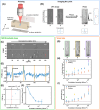Multi-photon polymerization using upconversion nanoparticles for tunable feature-size printing
- PMID: 39634588
- PMCID: PMC11501605
- DOI: 10.1515/nanoph-2022-0598
Multi-photon polymerization using upconversion nanoparticles for tunable feature-size printing
Abstract
The recent development of light-based 3D printing technologies has marked a turning point in additive manufacturing. Through photopolymerization, liquid resins can be solidified into complex objects. Usually, the polymerization is triggered by exciting a photoinitiator with ultraviolet (UV) or blue light. In two-photon printing (TPP), the excitation is done through the non-linear absorption of two photons; it enables printing 100-nm voxels but requires expensive femtosecond lasers which strongly limit their broad dissemination. Upconversion nanoparticles (UCNPs) have recently been proposed as an alternative to TPP for photopolymerization but using continuous-wave lasers. UCNPs convert near-infrared (NIR) into visible/UV light to initiate the polymerization locally as in TPP. Here we provide a study of this multi-photon mechanism and demonstrate how the non-linearity impacts the printing process. In particular, we report on the possibility of fine-tuning the size of the printed voxel by adjusting the NIR excitation intensity. Using gelatin-based hydrogel, we are able to vary the transverse voxel size from 1.3 to 2.8 μm and the axial size from 7.7 to 59 μm by adjusting the NIR power without changing the degree of polymerization. This work opens up new opportunities to construct 3D structures with micrometer feature size by direct laser writing with continuous wave inexpensive light sources.
Keywords: additive manufacturing; hydrogels; light-based 3D printing; multi-photon polymerization; photopolymerization; upconversion nanoparticle.
© 2022 the author(s), published by De Gruyter, Berlin/Boston.
Figures




References
-
- Najmon J. C., Raeisi S., Tovar A. 2 – review of additive manufacturing technologies and applications in the aerospace industry. In: Froes F., Boyer R., editors. Additive Manufacturing for the Aerospace Industry . Amsterdam: Elsevier; 2019. pp. 7–31.
-
- Lalegani Dezaki M., Mohd Ariffin M. K. A., Hatami S. An overview of fused deposition modelling (FDM): research, development and process optimisation. Rapid Prototyp. J. 2021;27(3):562–582. doi: 10.1108/RPJ-08-2019-0230. - DOI
-
- Gunasekaran J., Sevvel P., John Solomon I. Metallic materials fabrication by selective laser melting: a review. Mater. Today: Proc. 2021;37:252–256. doi: 10.1016/j.matpr.2020.05.162. - DOI
LinkOut - more resources
Full Text Sources
Miscellaneous
